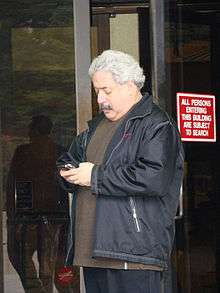Lee Abrams
| Lee Abrams | |
|---|---|
 | |
| Born |
1952 Chicago |
| Occupation | Media executive |
Lee Abrams (born 1952) is an American media executive who has held a number of posts for large and influential companies, and is generally credited with developing the Album Oriented Rock format employed by hundreds of radio stations across the country, as well as co-founding XM Satellite Radio.
Career
Born in Chicago, Abrams became a radio DJ. He pioneered systematic audience research and psychographics, connecting people's lifestyles to their listening habits. He invented the album-oriented rock music format, or AOR, which in the 1970s shifted the music industry's focus from singles to albums. Some of his other work at this time included numerous voice-overs, notably the introduction commentary in Let's Talk About Me from the 1984 Alan Parsons Project album, Vulture Culture. Abrams co-founded of XM Satellite Radio and served as Chief Programming Officer at that company until his departure in 2008. More recently Abrams was the chief innovation officer for the Tribune Company (2008–2010) but prior to that, founded and ran notable radio consulting company Burkhart/Abrams, served as an internal consultant for ABC Radio, and helped develop nationwide radio formats such as Z-Rock and Radio Disney.
Additionally, he has been involved on the recording side of the music industry, producing Ah Via Musicom for guitarist Eric Johnson and appearing on several Alan Parsons Project CDs. He has also consulted and managed acts such as Yes, The Moody Blues, Steve Winwood, Iron Maiden and Bob Seger.[1]
Recognition
Newsweek listed Abrams as one of their "100 Cultural Elite" in 1993, and he was cited by industry publication Radio Ink as one of the 75 most important radio figures of all time.[2]
Abrams was inducted into the Rock Radio Hall of Fame in the "Legends of Rock Radio-Programming" category for his work with WRIF in 2014.
Email controversy
On October 15, 2010, Abrams resigned from Tribune Company following revelations that he wrote an email to staff with a link to a video that some within the company considered offensive.[3]
That same day, New York Times public editor Arthur S Brisbane published an editorial questioning his paper's use of anonymous sourcing as one of the "load bearing" elements of the story, particularly as it was a "sensational episode" in a story about a competitor.[4]
On October 19, 2010, Forbes reporter Jeff Bercovici published an email from Abrams defending himself, including some specifics not included in mainstream coverage, notably, that the video was from parody site The Onion and that it had been previously shown at a Chicago Tribune sales meeting to a positive reaction.[5]
References
- ↑ Martin, Richard (October 2004). "Would You Buy the Future of Radio From This Man?". 12.10. Wired. Retrieved 2007-11-11.
- ↑ Fred Deane (June 9, 2006). "Up Close with XM Satellite Radio SVP & Chief Creative Officer Lee Abrams". FMQB. Retrieved 2010-10-15.
- ↑ Pulley, Brett (October 15, 2010). "Tribune Co. Executive Abrams Resigns After `Offensive' E-mail With Video". Bloomberg. Retrieved 2010-10-15.
- ↑ Brisbane, Arthur S. (October 19, 2010). "Unnamed Sources in Tribune Story Lead Weigh on Readers' Trust". New York Times. Retrieved 2010-10-15.
- ↑ Bercovici, Jeff (October 19, 2010). "Tribune's Lee Abrams Defends Himself: "I Will Not Stop Pushing"". Forbes. Retrieved 2010-10-15.